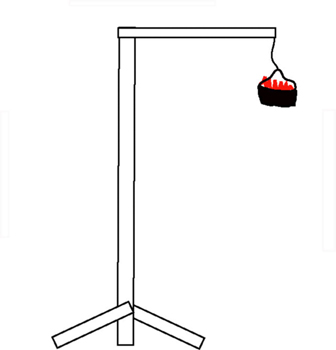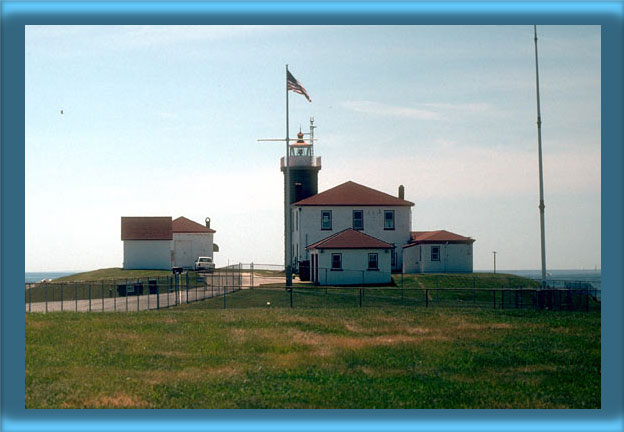| Warning Beacon |
|---|
 |
| Created by R. Holmes |
In 1794, Jeremiah Olney, Collector of Customs at Providence, received two letters asking that a light be built at the entrance to Long Island Sound. One letter signed by fifty-four captains and ship owners wanted it placed on Little Gull Island. The other letter from Tench Coxe, Commissioner of the Revenue, wanted it built at Watch Hill. Both sides argued for years before the matter was finally settled by building lights at both sites.
In 1807 the US Lighthouse Establishment purchased four and half acres of land on Watch Hill Point for Watch Hill Lighthouse from George and Thankful Foster for $500. The lighthouse, a thirty-five feet octagonal wooden tower, was completed in 1808. A five room wooden keeper's house was built near the lighthouse.
Early lighthouses used a combination of a lamp and parabolic reflector to provide illumination. There were ten of these installed at Watch Hill Lighthouse. Its light characteristic was rare for a lighthouse at the time. It flashed. This was done using an eclipser . It was a piece of metal that would rotate around the lamps and reflectors and obscure them at regular intervals. A clock like mechanism turned the eclipser.
In 1856 a granite lighthouse was built at Watch Hill to replace the old Watch Hill Lighthouse. A fourth order Fresnel lens was installed in the new lighthouse. The lens cost $4000. The old keeper's house was replaced with a new two story brick keeper's house. The light characteristic was changed to a fixed light.
The waters off Watch Hill point were treacherous even with Watch Hill Lighthouse. Ships were wrecked off the point at least once a year. On August 28, 1857, during a violent storm, two ships were wrecked on the shore near the lighthouse, within hours of each other.
The first ship, the Pinion, a large sloop, struck a ledge near Watch Hill Lighthouse. The storm pushed it off the ledge and drove it onto Napatree Beach near the lighthouse. The ship was wrecked beyond repair. Captain Henry Chase and his three man crew got off the ship unhurt. All Captain Chase's money was invested in the ship, which was uninsured. Nelson Brown, Watch Hill Lighthouse's keeper, let the men stay at the lighthouse. He gave Captain Chase a suit of clothes and money to get home to Taunton. The Captain was despondent about the loss of his ship and the income it provided for his three children. He said, "Were it not for them, he could wish to be buried with his sloop on the beach."
The second ship, a small sailboat, was wrecked near the lighthouse later that day. The storm forced David Martin to anchor near the lighthouse. He was so drunk that he didn't set his anchor correctly and was pushed onto the rocks on the east side of the lighthouse. He survived the wreck.
On August 30, 1872 the steamship Metis was traveling overnight from New York to Providence. The weather was overcast and rainy. At 3:40 a.m. the schooner Nettie Cushing hit the Metis five miles off Watch Hill Point. The Nettie Cushing escaped with minor damage and was able to make it to shore. At first it seemed the Metis was undamaged and continued on its way. It wasn't. The ship had a hole in it and was taking on water. The lifeboats were launched but there weren't enough for all the passengers. One of the lifeboats was swamped, but the chief engineer righted it and rowed back to the ship. He was able to rescue fifty people.
There were still fifty people on the ship. They were gathered on the ship's upper deck. It broke away from the Metis and floated to a beach a half mile east of Watch Hill Lighthouse. Two small boats, manned by ten men, were launched to save the survivors. One was led by Watch Hill Lighthouse Keeper Jared Crandall. The boats rowed out and pulled thirty-two survivors from the water. The ten men were awarded gold medals by Congress in 1873 for their efforts in saving the passengers.
In 1879 Jared Crandell died. His wife Sally Anne replaced him. She served as Watch Hill Lighthouse's keeper for ten years. During the summer months guests at local hotels would visit the lighthouse. Sally would give the guests tours of the light. Most of them would give her a dime or quarter at the end of the tours. When she retired in 1888, Fanny K. Sckuyler replaced her. A woman keeper replacing another woman keeper was extremely rare. Usually the only way for a woman to become a keeper was to replace their lighthouse keeper husband or father when they died.
On September 21, 1938 one of the most powerful hurricanes in American history hit Rhode Island. The keepers Lawrence Congdon and Richard Fricke kept the light on during most of the storm. Congdon said that waves broke over the top of the lighthouse, breaking the windows in the lantern, damaging the lamps. It was out of commission for a few weeks. After the storm, Watch Hill Lighthouse was a virtual island. The hurricane eroded the land around the lighthouse and damaged the seawall.
During World War II the government built a concrete watch tower near Watch Hill lighthouse. It was torn down in 1950.
Panoramic View of Watch Hill Point
Watch Hill Lighthouse was automated on August 31, 1986. The Watch Hill Lighthouse Keepers Association signed a thirty year lease with the Coast Guard that day. The fourth order Fresnel lens was removed after the light was automated. It was replaced with a FA-251 beacon. The fourth order Fresnel lens was given to the Association. It's kept in small museum near the lighthouse.
In August 2011 Tropical Storm Irene damaged 200 feet of the eastern seawall at Watch Hill Lighthouse. The damage was so bad that the Watch Hill Lighthouse Keepers Association Board thought it was in danger of collapse. The board decided to spend $100,000 to repair it. The Association president, William White, said it was the biggest expenditure in the history of the Association. The work was completed in October 2011.
The U.S. General Services Administration issued a Notice of Availability for the Watch Hill Lighthouse on May 7, 2021, because it was determined as excess to the needs of the United States Coast Guard. Under the National Historic Lighthouse Preservation Act of 2000, lighthouses are made available to federal agencies, state and local agencies, non-profit corporations, educational agencies or community development organizations for educational and park, recreational, cultural, or historic preservation purposes at no cost.
Any group that wants the lighthouse has 60 days form the issued a Notice of Availability to submit a letter of interest to the General Services Administration. Every group that sends a letter, will receive an application from the United States Department of the Interior, National Park Service. The Coast Guard will announce a date for an inspection of the lighthouse. All the interested groups will get a chance to inspect the lighthous. They have to submit an application within 90 days from the inspection.
The National Park Service will review the applications. This could take anywhere from 6 to 12 months. They will make a recommendation to the General Services Administration on who should receive the lighthouse. The General Services Administration will transfer ownership of the lighthouse to the selected group. If government groups or non-profit organizations don't want the lighthouse, it will be offered for sale to the public.
See more of Watch Hill Lighthouse in Rhode Island Lighthouses: A Pictorial History by R Holmes.
For information
on the Block Island North Lighthouse, contact:
Watch Hill Lighthouse Keepers Association
14 Lighthouse Road
Watch Hill, RI 02891
Watch Hill Lighthouse Keepers Association
14 Lighthouse Road
Watch Hill, RI 02891
